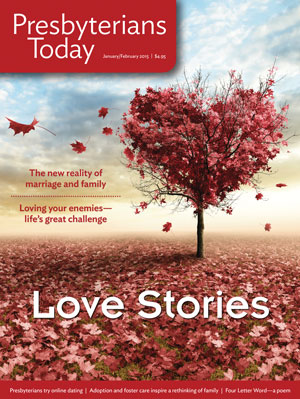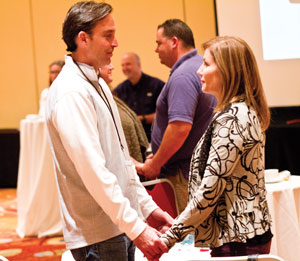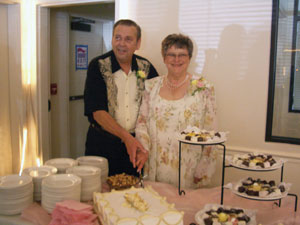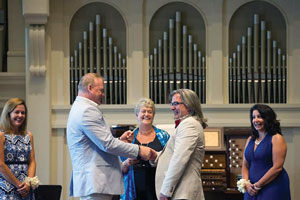 The new reality of marriage
The new reality of marriage
Changes in society lead to questions about what it means to be married.
by Marci Glass
When Esther Olsen graduated from high school in the mid-1950s, she did what many other young women of that era did: enrolled in nursing school. Soon afterward, she started dating George Auld, a respiratory therapist. When the couple got married, nursing school fell by the wayside. By society’s standards, Esther didn’t need a career anymore—she’d found a husband. And, predictably, children followed a few years later.
By all accounts, George and Esther were living the American dream.
I should know; I’ve heard the story many times. George and Esther are my parents.
By the time I went to college in the late ’80s, I could no more imagine dropping out of college to get married than I could picture going to Mars. I did get married a year out of college, even if that was not my plan.
The first time we talked, I told my future husband, “I’m so glad I’m single and won’t be following some guy around the country after graduation.”

A marriage retreat hosted by Memorial Drive Presbyterian Church in Houston
Economic realities also had changed by the late ’80s. Both parents had to be breadwinners in an increasing number of families—if the parents were even still married. My generation grew up as latchkey kids and the children of divorced parents.
In the decades since, the institution of marriage has continued to evolve. Along the way, many Presbyterians have had to confront issues that were rare or at least not talked about when their parents married—issues such as cohabitation, out-of-wedlock births, and same-sex marriage.
My parents have been married 58 years now, but during that time they’ve witnessed seismic shifts in the institution of marriage. Even the prevalence of marriage has declined. In fact, the US marriage rate is at an all-time low: only 51 percent of adults were married in 2011, according to the Census Bureau. And the percentage of American adults who have never been married is at an all-time high, according to the Pew Research Center.

Sean Rogers, a PC(USA) church musician, used to perform at about 20 weddings per year, but that number has dropped dramatically because fewer people are getting married in churches, he says.
“Fifty years ago, you had to be married,” says Andrew Cherlin, a professor of public policy and sociology at Johns Hopkins University, in a 2011 CNN report. “Marriage used to be the first step in adulthood, and now it’s the capstone.”
Finances and other concerns
Economic realities, such as debt, transience, and high rates of un- or underemployment, are playing a big role in many people’s decision to postpone marriage.
“People are waiting till they are settled in a stable job to get married,” Kelly Raley, a professor of sociology at the University of Texas at Austin, told CNN.
The median age at first marriage is now 27 for women and 29 for men, up from 20 for women and 23 for men in 1960, according to Pew Research.
Along with the rising age at first marriage, Pew reports that growing numbers of couples are forgoing marriage altogether or are living together before they marry. A 2010 Pew survey found that 44 percent of all adults (and more than half of those ages 30 to 49) say they have cohabited at some point. Among those, about two-thirds say they thought of that living arrangement as a step toward marriage. A number of Presbyterian clergy report anecdotally that in the past 10 years most of the couples they married were living together before the wedding. Yet about a third of the population (31 percent) believes that sex between an unmarried man and unmarried woman is morally wrong, according to a May 2014 Gallup poll.

Marci Glass’s parents celebrate their 50th wedding anniversary.
Reasons for living together rather than marrying are varied. Some say they don’t need a license or a ceremony to prove that they love each other, while others cite economic factors or say they’re delaying the decision to marry because marriage is so important to them.
Jordan Multerer, a 24-year-old accountant from Boise, Idaho, says she would consider living with her boyfriend, who is deployed in the Marine Corps. Living together would be a way of “making sure we’re a good fit before marriage,” says Multerer, who has been dating her 28-year-old boyfriend for two years. “For me, marriage is a must, and divorce isn’t an option. We need to work through the bad and fight for each other. So many people are so quick to throw the d word on the table.”
Brooklynn Smith, a 23-year-old PC(USA) seminarian, understands those sentiments.
“I think there are things we learn about people that we only learn through living with them,” she says. “I think it is especially common these days to live together because paying two rents and trying to save for a wedding or anything else would be next to impossible for a lot of couples around my age. Also, marriage isn’t a legal or religious possibility for many couples, so living together is a kind of spiritual, emotional commitment for them. For those who can marry and don’t: they have probably seen, like me, a really bad cultural track record for marriage.”
For couples who choose to get married, a church is no longer the de facto wedding site. With the rise of “destination weddings” and marriages in parks, backyards, and other secular venues, the number of church weddings has declined significantly. Sean Rogers, a PC(USA) church musician, says: “I used to play at 20 or more church weddings a year. That number is down to about three. My colleagues have also seen a similar drop in weddings taking place in church buildings.”
Likewise, attitudes toward children in relation to marriage have changed. With the proliferation of birth control, children are no longer a foregone conclusion in marriage. And marriage is no longer seen as the only acceptable gateway to parenthood: the share of births to unmarried women has risen from 5 percent in 1960 to 41 percent in 2008, according to Pew Research.
And alongside these broad changes in marriage patterns generally, same-gender marriage is on the rise. As of late October, same-sex marriage was legal in 31 states and the District of Columbia.
Defining marriage
The 221st General Assembly (2014) of the Presbyterian Church (U.S.A.) dealt with marriage equality in two ways. It voted to allow discretion for clergy to participate in same-gender marriages in civil jurisdictions where such marriages are legal. The assembly also approved a constitutional amendment to the Book of Order that would change the definition of marriage from “between a man and a woman” to “between two people, traditionally a man and a woman.” In order for that measure to take effect, it must be approved by a majority of the denomination’s 172 presbyteries.
As presbyteries deliberate and cast their votes, Presbyterians remain divided on the faithfulness of same-gender marriage and its compatibility with Scripture. A minority would even like to see the church get out of the business of civil marriages altogether.
Pastors, in that case, would no longer be agents of the state, beholden to its definitions, but free to perform purely religious services of blessing and covenant. An overture to this effect was made to the most recent General Assembly but failed.
Other Presbyterians find hope in the prospect of marriage equality, believing it actually could offer an antidote to other social changes that threaten the covenantal bonds of marriage.

Susan Andrews, moderator of the 215th General Assembly (2003) and general presbyter of Hudson River Presbytery, presides at the wedding of Matthew Rupcich and Patrick Field.
“I think gay marriage is the best thing that’s happened to the institution of marriage in 100 years,” says Susan Andrews, moderator of the 215th General Assembly (2003) and general presbyter of Hudson River Presbytery. “While others are thumbing their nose at the institution of marriage, gay people are claiming marriage because they want a deep, spiritual, lifelong, monogamous commitment blessed by God.”
She officiated at the marriage of two men at the Peabody Conservatory in Baltimore, who were married on their 20th anniversary, having decided to wait for marriage equality in their home state of Maryland. It mattered to them to have a Christian ceremony, presided over by a minister.
“When they called me a year ago to ask me to officiate, I started crying. The church had been a place where they had been loved, embraced, and supported, so it meant a lot to make public what had been private for 20 years, and to do so before God and their families,” she says.
“I met with this couple, as I do with all couples, and their commitment, their understanding and celebration of differences, their commitment to monogamy, their love, their understanding of God’s presence in their relationship—it was so strong,” Andrews says.
“If you juxtapose what the culture is doing to marriage—setting it aside as optional—with the deep desire of same-gender couples to have God bless their lives together, why would the church not be for this?” asks Andrews.

A husband and wife talk intimately during a marriage retreat hosted by Memorial Drive Presbyterian Church in Houston.
Against the backdrop of same-gender weddings and other social changes, Presbyterians and other Christians are weighing what Christian marriage really means.
“It is a strength of the Presbyterian tradition to know we can look at marriage, discuss and debate how theology and Scripture relate to it, and seek understanding together through our differences,” says Charles Wiley, coordinator of the PC(USA) Office of Theology and Worship.
In 2013 the Office of Theology and Worship produced a study on marriage designed to help the church engage in serious study and discernment concerning the definition of marriage and whether or not same-gender relationships fit into the Reformed understanding of Christian marriage.
“One of the most surprising insights to participants in the marriage study across the denomination was the idea that marriage is not simply the joining together of two people with romantic attraction who want to spend the rest of their lives together,” says Chip Hardwick, director of Theology, Worship, and Education.
Learn more
The PC(USA) marriage study and a map of presbytery voting results on same-gender marriage is available online at pcusa.org/marriage.
“By looking at the confessions and Scriptures, participants realized that marriage is one way that the Spirit makes our lives look more like Jesus’. Christian couples have the chance to challenge, support, and nurture each other’s faith daily and in a more intimate way than other kinds of relationships allow. Moreover, they discovered that mutually sacrificial love between spouses can serve as a parable of God’s love for the church—a love that is passionate, demanding, and life-giving.”
Marci Glass is the pastor of Southminster Presbyterian Church in Boise, Idaho. She also serves on the boards of the Presbyterian Mission Agency, the Covenant Network of Presbyterians, and Ghost Ranch retreat and conference center. Her blog, Glass Overflowing, can be found at marciglass.com.


